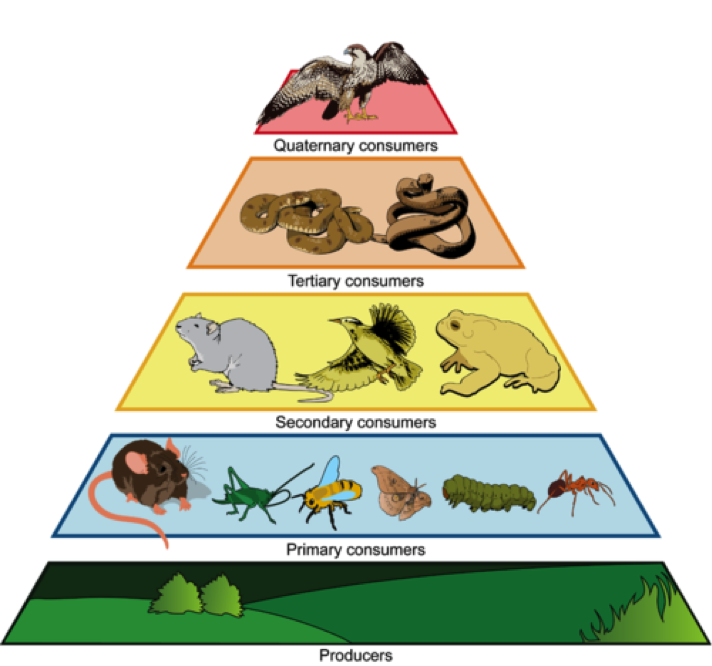Some say that we live in a dog-eat-dog world, but perhaps more accurately we live in a dog-eat-deer-eat-grass-whose-seeds-are-eaten-by-mice-eaten-by-hawk-decomposed-by-microbes world. Creatures in the natural world eat and are eaten in interconnected webs; we’re used to thinking of organisms as predators or prey, but there are more specific terms for a creature’s place in the consumptive order. These terms group organisms into what are known as trophic levels. Trophic levels provide a means to place organisms into containers based on their place in the energy transfer web of an ecosystem. In the lowest trophic level are the autotrophs, or primary producers—organisms like plants and certain bacteria that are capable of taking inorganic molecules and using light or chemical energy to convert them into organic molecules through processes like photosynthesis. In other words, they don’t need organic carbon from other life forms to survive. In the next trophic level up are the primary consumers, also called heterotrophs—organisms that consume primary producers. This trophic level includes insects and animals such as deer and mice. The organisms that prey on the primary consumers are the secondary consumers, and the organisms eating the secondary consumers are the tertiary consumers. Tertiary consumers may be what are known as apex predators, defined as predators that are at the top of the food chain and are not eaten by anything else; however most marine ecosystems include quaternary consumers that eat tertiary consumers. Detritivores are organisms that get energy from the consumption of detritus, or organic matter derived from dead plants and animals, and function as heterotrophs.
Interactions between the trophic levels can be quite complex, and sometimes nonlinear. Different ecosystems contain different numbers of trophic levels, and it is possible for organisms to feed at different trophic levels. For instance, a bird may eat seeds from a tree as a primary consumer, but may also eat insects as a secondary consumer. It is also possible for disturbances in one trophic level to affect not only the trophic level above or below, but also trophic levels once or twice removed. When this happens in terms of a predator’s impacts being felt more than one trophic level down from them, it is called a trophic cascade. Predators affect the density and behavior of their prey, and the abundance of prey animals and their behavior in turn affects the abundance and location of a system’s autotrophs.
Humans are often the instigators of trophic cascades: we alter ecosystems and ecosystem interactions by removing vegetation, hunting animals, and removing organisms we see as pests. During the 1920’s the Forest Service launched a campaign to remove top predators from the the Kaibab Plateau, which is the area northeast of Grand Canyon National Park in Arizona. They killed and drove out wolves and mountain lions in an effort to increase the local mule deer population. Deer were a favorite animal at the time due to the success of the film “Bambi”, and, ironically, the popularity of deer hunting. The Park Service and the State of Arizona believed that a large deer population would bring in revenue from tourism and hunting, and did not consider the potential consequences of removing apex predators. The mule deer population of the Kaibab Plateau shot up by the thousands after the predator removal. However, the increase in the number of deer lead to a sharp decrease in the area’s aspen population, which was the deer’s primary food source. Without enough aspen to sustain them, the deer began to die, and their numbers were reduced to below pre-1920’s levels. A similar story can be told for Zion National Park during the mid 1900s. The increase of human activity in the Park lead to the emigration of native pumas. The number of mule deer sky-rocketed without their natural predator to keep them in check, and cottonwood density decreased radically. The cottonwoods served other ecosystem functions, and their removal had more far reaching consequences. Without the cottonwood root system to keep soil in place, river banks eroded and species reliant on riparian habitat, such as frogs, butterflies, and wildflowers, died out from those areas.
Non-consumptive affects of predators, meaning affects that aren’t directly related to predators killing and eating prey, have also been studied, and it has been postulated that the presence of pumas in Zion changes the way deer eat: if predators are present they’ll browse in an area for a short time and then move on, whereas when predators aren’t present they may be more likely to browse for longer stretches of time in the same place, more significantly reducing the abundance of plant species in that area. Other examples of non-consumptive predatory affects to prey species include changes to organisms’ reproductive rates, their growth, and their temperature tolerance. Interactions between trophic levels can be very complex, and trophic cascades can lead to unexpected ecosystem consequences.

